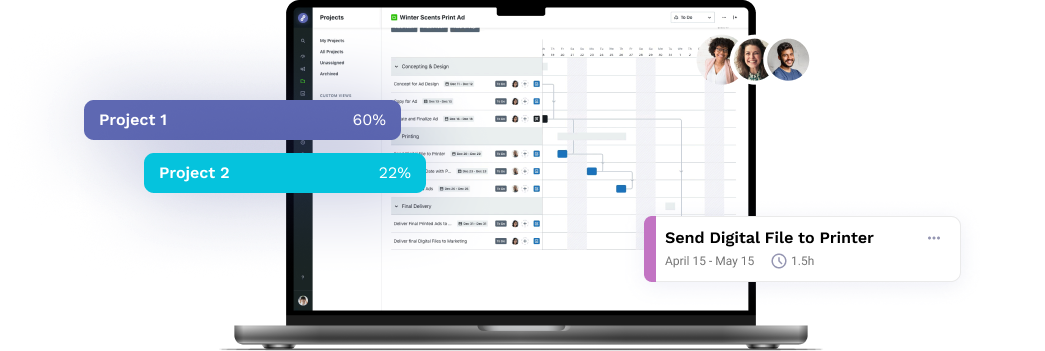
If you are part of or lead a creative team, you have probably witnessed someone’s epic eye roll when file naming conventions come up. Maybe you were the person that eye-rolled. Or you brought up the topic and locked eyes with that colleague mid-eye roll. Sound familiar? Whatever the case may be, you may wish to do something about that passive-aggressive behavior before reading on.
Chances are most of us want to follow file naming conventions for projects and files. Easier said than done, though. You see, creating your set or framework of them is the easy part. Following through with it and getting everyone else to use it same way you do is the real challenge.
Why Are File File Naming Conventions Essential?
Because they come with quite a few benefits. These include:
1. File Naming Conventions Help You Tell Similar Projects Apart
Are you working on multiple videos, brochures, and presentations? All you have to do is give the assets unique names that include the project name. And voila! You can tell copies of the same asset apart just like that. You can now work on the specific changes you need to make to each asset, depending on each project’s needs.
2. They Keep Everyone on the Same Page
File naming conventions are like a code – if you know the code, you can glean a lot of information about a campaign or project just from looking at its name. This is doubly useful when you are looking back at archived work. And since codes can be learned, file naming conventions don’t rely on institutionalized knowledge – even the new guy can find anything he needs if he knows the code.
3. File Naming Conventions Save You Lots of Time
If you use file naming conventions, you go into any search situation armed with the best information – you already know the name of the thing you are looking for, or at least part of it. For example, if you know you are looking for a video that was produced in January 2019, and you use dates and project types in your file naming convention, you already have a significant portion of the name to search, which tends to work better than just searching “video”.
4. They Help Prevent Reworks and Double Work
As unpleasant as it can be to have to sift through a bunch of files or work items, opening and closing them to figure out which one is the one you need, what’s even worse is going through all of that, only to choose the wrong item, and spend a couple of hours working on the wrong project. File naming conventions ensure that you’ve found the right file and aren’t wasting precious work hours on something you’ll just have to redo later.
Why Are We Finding It So Challenging to Use File Naming Conventions Correctly?
We might want to believe that we can power our way through file naming conventions, and do so consistently. The truth is that the biggest failure of file naming conventions is human nature. Following through on this front requires immense discipline in doing something repetitive time and again. And repetition is just something we do not like to engage in.
If you were to take the time to manually name all our work following a set convention, it would feel tedious. Thankfully, we have computers for that – wonderful robots that revel in that sort of tedium. And that’s it really. The secret to having successful file naming conventions is using them, and the secret to using them is having a computer to do it for you.
For this reason, part of the tools that Lytho offers includes a feature that allows teams to set up naming rules that are applied to all following campaigns and projects. Using it, creative teams can set up naming conventions that include:
- Dates (submitted, approved, created, and due)
- Auto-numbers
- Custom fields
Once you have set up the convention framework of your choosing on the account, all new projects and campaigns created will be automatically tagged accordingly. And what happens when you remove the manual process of naming campaigns and projects? Your creative team is finally free of having to perform all those soul-crushing, boring tasks. And this, in turn, allows them more time and energy to do what they do best – be creative.
Recommended reading: The Importance of Naming Conventions
Lytho helps you streamline your entire workflow and harmonize all brand collateral under a single, uniform platform. Feel free to reach out to us by scheduling a demo and learning how our creative solutions can boost the effectiveness of your creative projects. We look forward to speaking with you!
Do you want to give yourself and your creative team more room for creative stimulation by automating the boring stuff? Lytho helps you streamline your entire workflow and harmonize all brand collateral under a single, uniform platform. Feel free to reach out to us by scheduling a demo and learning how our creative solutions can boost the effectiveness of your creative projects. We look forward to speaking with you!

Ready to simplify your creative operations and start having a little fun at work again? Schedule time to talk with us.
Let us show you how Lytho’s Creative Operations Platform helps in-house creative and marketing teams do better work, ease the stakeholder experience, and stay on brand.
Schedule a Demo